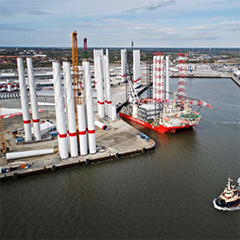Ports display the economic growth engines in the economy of countries. Increased activity requires larger ports, capable of handling a larger volume of traffic representing buoyant import-export balances. However, the epitome of ports also presents the consumables of natural resources, represented by the goods moving over the quay side. It could be argued that ports have an obligation to be the pacesetter for sustainable development, given that they are both instrumental and a longstanding economic driver.
Marsh to modern urbanity
On the West coast of Denmark lies Port Esbjerg, which was inaugurated in 1868 and therefore is a young generation port compared to other major European ports, which date back to the middle ages. Ports have evolved over centuries and must be considered in the context of the progression of the industries they support, whilst also recognizing that a port, its industry and society are intertwined.
Development has been progressive at Port Esbjerg. It has created a resource base and infrastructure, which support change when compared to other ports. The multifaceted types of cargo and operations conducted in here portray a myriad of markets allowing for resilience. Even so the question must be asked: are the vicinity’s actors, stakeholders or implementors facilitating this phenomenon?
From the outset Port Esbjerg has followed a linear path from exporting cattle to fisheries and the present energy mix, supporting the oil, gas and renewable markets. A plausible explanation of the change may be found in the neighborhood, but this does not dictate the ability to transform, adapt and cater for the differentiation needed, for the evolutionary economics portrayed.
Hinterland hub to integral player
According to Observatory of Economic Complexity, Denmark is the 38th largest export economy in the world and the 19th most complex, measured by the economic complex index. The top exports are pig meat, refined petroleum and medicaments, whereas the top imports are cars and crude petroleum. This data draw parallels to Port Esbjerg and the variance of cargoes, but further analysis of the activities displays a coevolution, with integral players in the main areas of the energy mix, modular traffic and circular economy.
Port Esbjerg supports the renewable industry, where the largest components to offshore wind projects are pre-assembled and loaded. The maintenance and operations are also directed from here, for numerous windfarms in the area. In addition, a significant number of onshore wind turbine components are shipped around the world from Port Esbjerg.



























